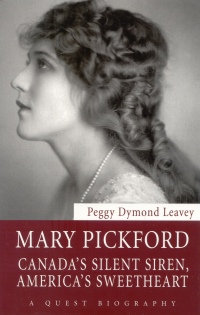| ________________
CM . . . . Volume XVIII Number 20 . . . . January 27, 2012
excerpt:
Mary Pickford was born Gladys Smith in 1892 in a house on University Avenue in Toronto where the Hospital for Sick Children now stands. The eldest of three children, she was often a substitute caregiver for her siblings, especially after her father died and the family struggled to survive. Looking out for her family became a life-long practice.
Silent film was becoming popular. Flickers,” as they were known, were short one-reel films. This new medium was initially scorned by theatrical artists, but the new industry offered employment during the summer months when the theatres were chiefly inactive. At the age of 17, Mary made her debut in a D.W. Griffith’s production, playing the role of a 10-year-old child. During 1909, she went on to make 45 films with Griffith. At this time, New York was still at the heart of the new industry. Leavey’s biography is somewhat uneven. At times, it gets bogged down detailing titles of films, minor facts and dry corporate history. She successfully uses imagined dialogue and quotations from Pickford’s own memoirs to add zest to the narrative. She also succeeds in portraying Pickford as an ambitious young woman who managed to negotiate contracts that saw Pickford become, by 1916, the highest paid woman in the world. By this time, she was making full-length feature-length films, survived a disastrous marriage, established the Mary Pickford Film Corp. within Famous Players and was producing her own films. In 1919, she, along with actors Douglas Fairbanks and Charlie Chaplin, D.W. Griffith and another investor, founded United Artists, a motion picture company designed to distribute their own films and maximize their profits. Information about the evolving nature of the film industry is a valuable part of the work. The chronology, a feature of all titles in the “Quest Biography” series, is especially noteworthy for highlighting innovations in the movie industry in the column chronicling events about Canada and the world. One unfortunate error slipped in: Armistice Day (Nov. 11, 1918) appears under 1917. Mary’s marriage in 1920 to athletic silent screen star Douglas Fairbanks served to boost her popularity. Movie magazines helped to foster the celebrity craze that reached new levels and continues with Hollywood couples today. Pickford struggled to break free from roles requiring her to play young women or even children. The silent film era ended as talking pictures became standard. This transition was challenging for Pickford as she was uncomfortable with the microphone. More importantly, Leavey points out, by the early 1930s and the age of forty, the reality was that Pickford was aging and her popularity was waning as fans looked to new, younger actors to idolize. Pickford was one of the founders of the Academy of Motion Picture Arts and Sciences, won the best actress Academy Award for her role in her first talking movie, Coquette in 1930, and was a supporter of many philanthropic and humanitarian ventures, including the Mary Pickford Foundation. The darker moments of her life are also captured with the break-up of her marriage to Fairbanks, unhappy relationships with the two children that she adopted with her third husband, Buddy Rogers, and the grief caused by her siblings’ self-destructive behaviours and early deaths. She, too, came to struggle with alcohol. Many of her later business ventures were not successful. Ironically, Pickford’s decision to suppress commercial re-release of her films until 1970 may have contributed to her fading from public memory. Many of her 200 films, including almost half of her 52 feature-length movies, are no longer extant. At one time, she tried to destroy prints of her early films and later chemical disintegration of the unstable nitrate made it impossible to transfer some of the prints to acetate when this work was undertaken in the 1950s. Fortunately, thousands of film stills, movie posters and related memorabilia are preserved in archives and libraries. Almost a dozen photographs from various periods of Pickford’s life add appropriate visual content to this volume that also includes a suitable index and a bibliography that includes a couple of documentary films and two websites, one being an entry from the Mary Pickford Institute for Film Education. No filmography is provided, but readers using the website noted or their own exploration on Wikipedia can quickly find a filmography online, not to mention YouTube video clips that show snippets of Pickford from both her silent and talking roles in early film. Recommended. Val Ken Lem is a librarian at Ryerson University in Toronto, ON.
To comment
on this title or this review, send mail to cm@umanitoba.ca.
Copyright © the Manitoba Library Association. Reproduction for personal
use is permitted only if this copyright notice is maintained. Any
other reproduction is prohibited without permission.
NEXT REVIEW |
TABLE OF CONTENTS FOR THIS ISSUE
- January 27, 2012.
AUTHORS |
TITLES |
MEDIA REVIEWS |
PROFILES |
BACK ISSUES |
SEARCH |
CMARCHIVE |
HOME |
